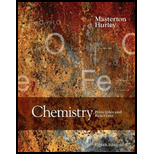
Concept explainers
(a)
Interpretation:
The temperature of both the gases needs to be compared if the number of moles of SO2 in the tank A is twice the number of moles of O2 in tank B.
Concept introduction:
According to the
When at two different conditions gases are placed, then to determine the changed variable combined gas law is used. Below is the formula of combined gas law:
Here
- P1 and P2 are the pressure of gases
- V1 and V2 and volume of gases
- n1 and n2 number of moles
- T1 and T2 are the temperature of gases
(b)
Interpretation:
The temperature of both the gases needs to be compared if the number of moles of SO2 in the tank A is equal to the number of moles of O2 in tank B.
Concept introduction:
According to the ideal
When at two different conditions gases are placed, then to determine the changed variable combined gas law is used. Below is the formula of combined gas law:
Here
- P1 and P2 are the pressure of gases
- V1 and V2 and volume of gases
- n1 and n2 number of moles
- T1 and T2 are the temperature of gases
(c)
Interpretation:
The temperature of both the gases needs to be compared if the mass of SO2 in the tank A is twice the mass of O2 in tank B.
Concept introduction:
According to the ideal gas law volume i.e. V, pressure i.e. P, number of moles i.e. m, temperature i.e. t and universal gas constant i.e. R are interrelated as below:
When at two different conditions gases are placed, then to determine the changed variable combined gas law is used. Below is the formula of combined gas law:
Here
- P1 and P2 are the pressure of gases
- V1 and V2 and volume of gases
- n1 and n2 number of moles
- T1 and T2 are the temperature of gases
Want to see the full answer?
Check out a sample textbook solution
Chapter 5 Solutions
Chemistry: Principles and Reactions
- PROBLEM 5) Can you explain this problem and solve it correctly, please!arrow_forwardPROBLEM 6) Can you explain this problem and solve it correctly, please!arrow_forwardGive the IUPAC name for the following alkenes. Include an E/Z designation where appropriate. Part 1 of 2 (E)-4,5-dimethylhept-2-ene Part 2 of 2 Sarrow_forward
- For the mechanism, show everything, lone paires, charges and arrow pleasearrow_forwardmolecule 0= OH ☐ ☐ type of molecule (check all that apply) fatty acid monoglyceride diglyceride triglyceride saturated unsaturated monounsaturated ☐ polyunsaturated ☐ ☐ ☐ ☐ ☐ 010 0 0 0 0 0 0 ☐ ☐ ☐ ☐☐☐☐ U omega-3 omega-6 fatty acid monoglyceride diglyceride triglyceride saturated unsaturated monounsaturated polyunsaturated omega-3 omega-6 fatty acid monoglyceride diglyceride triglyceride saturated unsaturated monounsaturated polyunsaturated omega-3 omega-6 OH OHarrow_forward'☐ : ☑ ด Suppose an alien life form has DNA just like human DNA remain the same.) - except that the alien DNA is made from deoxyarabinose instead of deoxyribose. (All other ingredients Draw the structure of a nucleotide containing thymine from which the alien DNA would be assembled. Note: be sure to draw the molecule as it would exist at physiological pH. Click and drag to start drawing a structure.arrow_forward
- Chemistry: Matter and ChangeChemistryISBN:9780078746376Author:Dinah Zike, Laurel Dingrando, Nicholas Hainen, Cheryl WistromPublisher:Glencoe/McGraw-Hill School Pub Co
 Chemistry: Principles and ReactionsChemistryISBN:9781305079373Author:William L. Masterton, Cecile N. HurleyPublisher:Cengage Learning
Chemistry: Principles and ReactionsChemistryISBN:9781305079373Author:William L. Masterton, Cecile N. HurleyPublisher:Cengage Learning Chemistry: The Molecular ScienceChemistryISBN:9781285199047Author:John W. Moore, Conrad L. StanitskiPublisher:Cengage Learning
Chemistry: The Molecular ScienceChemistryISBN:9781285199047Author:John W. Moore, Conrad L. StanitskiPublisher:Cengage Learning  General Chemistry - Standalone book (MindTap Cour...ChemistryISBN:9781305580343Author:Steven D. Gammon, Ebbing, Darrell Ebbing, Steven D., Darrell; Gammon, Darrell Ebbing; Steven D. Gammon, Darrell D.; Gammon, Ebbing; Steven D. Gammon; DarrellPublisher:Cengage Learning
General Chemistry - Standalone book (MindTap Cour...ChemistryISBN:9781305580343Author:Steven D. Gammon, Ebbing, Darrell Ebbing, Steven D., Darrell; Gammon, Darrell Ebbing; Steven D. Gammon, Darrell D.; Gammon, Ebbing; Steven D. Gammon; DarrellPublisher:Cengage Learning Chemistry for Engineering StudentsChemistryISBN:9781337398909Author:Lawrence S. Brown, Tom HolmePublisher:Cengage Learning
Chemistry for Engineering StudentsChemistryISBN:9781337398909Author:Lawrence S. Brown, Tom HolmePublisher:Cengage Learning Introductory Chemistry: A FoundationChemistryISBN:9781337399425Author:Steven S. Zumdahl, Donald J. DeCostePublisher:Cengage Learning
Introductory Chemistry: A FoundationChemistryISBN:9781337399425Author:Steven S. Zumdahl, Donald J. DeCostePublisher:Cengage Learning





